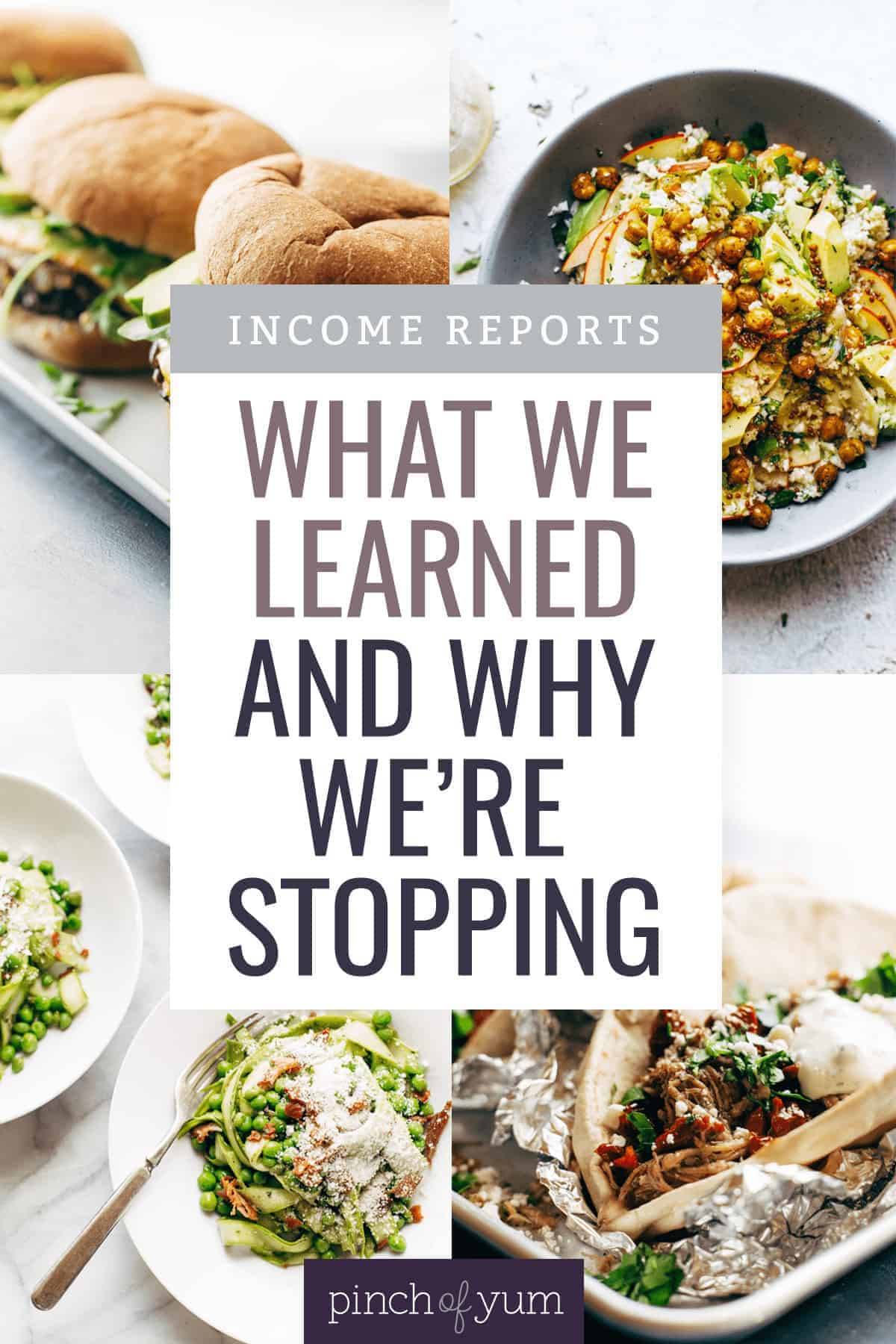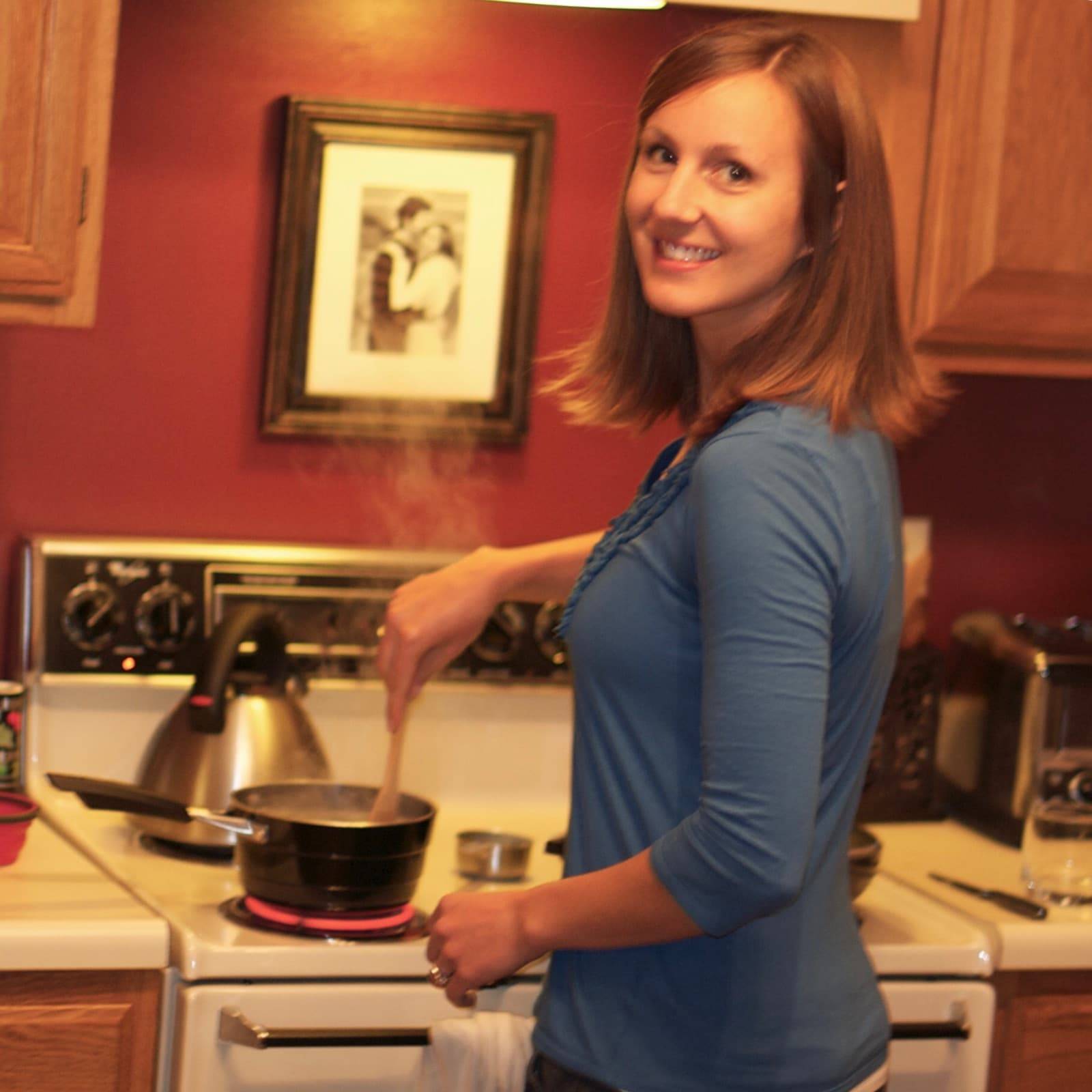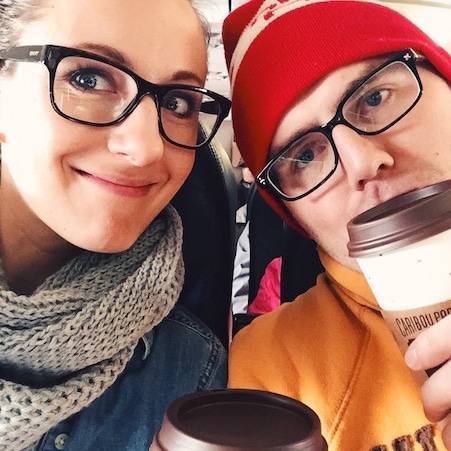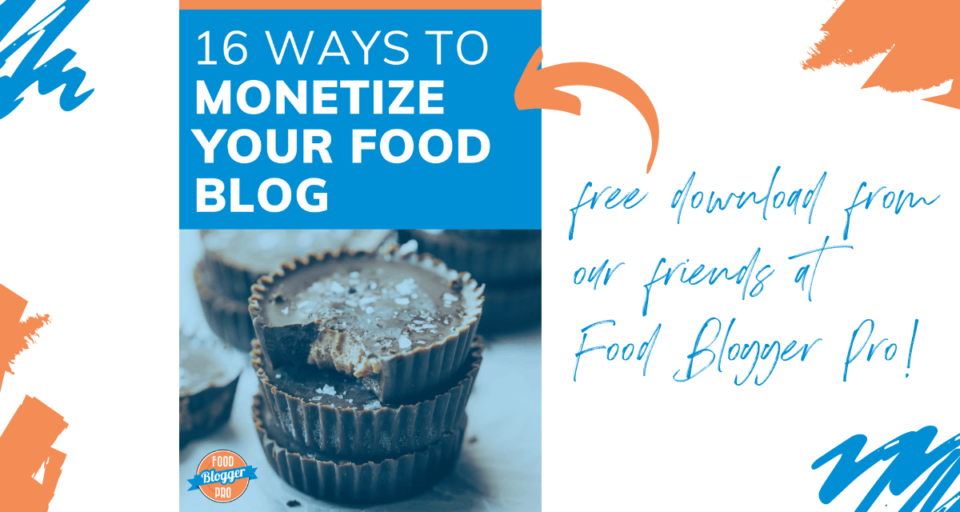
Bjork recorded an audio version of this blog post on The Food Blogger Pro Podcast. You can listen to the episode above or subscribe to the Food Blogger Pro Podcast on iTunes or the podcast app of your choice.
Hiya! 👋
Bjork here.
Nice to see ya again, my friend. It’s been a while!
Some of you might know that for the past 6 years I’ve been publishing an “Income and Traffic Report” each month that outlines POY’s revenue, expenses, and traffic. We published our first report waaaaay back on September 5th, 2011 and entitled it “the food blog money making experiment”. The total earnings for that month? $21.97.
I like thinking back to that time and imagining what it was like.
2011:

Lindsay was a fourth grade teacher, I was working at a non-profit, and we lived in a small condo just outside of the Twin Cities. We were figuring things out: what it was like to be married, to own a home, and to work a real job with a normal schedule. We were also figuring out what it meant to build a blog and publish content. Our little Pinch of Yum hobby happened in the margins of our days: early mornings, evenings, and weekends.
We had a belief, albeit abstract and unclear, that it was possible to build a blog that could thrive both in reaching and connecting with people as well as becoming a source of income. That abstract belief lead us to start a public experiment in creating an income from the blog. We chronicled the journey in these monthly reports over the course of six years.
We learned from others, we made mistakes, we refined our craft, we changed, we adjusted, we iterated. We stuck with it and took tiny steps forward every day. We continued to experiment.
2012-2014:

The blog was growing, both in followers and revenue. We were each working two full-time jobs. Lindsay was a teacher and a blogger. I was working at a non-profit and helping run Pinch of Yum.
We passed some major milestones – first time making $100/month, first time making $500/month, and first time making $1000/month. I still remember the day that we totaled up the income for that month and realized it was more than what were making from our day jobs. Along with that came the realization that this blog-as-a-business could be – and already was – “a thing.” In June of 2014, we both decided to leave our jobs and work on Pinch of Yum and Food Blogger Pro full-time.
At that point, in June of 2014, the experiment that we started back in 2011 had a concrete result: We found that it was indeed possible to start a blog and build it into a sustainable source of income.
2015-2016:

We continued writing the monthly reports as we entered into some major transitions – like taking the blog from a two-person show (Lindsay and I) into a “bigger” business, including a small and mighty team to help support the work, as well as a physical studio to host workshops, record videos, and office from.
After building our team and finding a beautiful office space, we had another concrete result in the experiment: Pinch of Yum transitioned from being a Ma and Pa shop to a business with an official team and a physical location to call home.
2017:

And now, as we reflect on what the last six years have been and look to what’s ahead this year and beyond, we’re ready to make yet another iteration to the blog. The pull is constantly changing in this line of work, and we can feel the winds of change at work again. With a deep sense of gratitude, we’ve decided that the monthly income reports have run their course.
This chapter has come to a close, making this the last post we’ll publish relating to the monthly income reports for Pinch of Yum.
How We Came To That Decision:
For a long time Lindsay and I have felt that regardless of what was said within the actual content of the income reports, the loudest part was always the money! part.
Creating an income (aka money!) from your business in and of itself isn’t a bad thing. Not at all, actually. It’s one of the main reason that businesses are created. To create an income. To pay the bills. To create freedoms that you otherwise might not have. To sustainably solve important problems. To allow you to support causes and people you care about. To grow and to scale and to expand… your mind. your resources. your relationships.
That being said, we feel more and more that the income reports don’t fit in on Pinch of Yum. As we experienced life-changing tragedy in our own lives, and as Lindsay has continued to write more and more about personal and important subjects, the reports have started to feel more and more out of place.
Here’s an analogy for the income reports:
They were kind of like a guy that shows up to a soccer game wearing a suit. Could he play? Yes. Would he fit in with the other players around him? No.
Strange analogy? Yes. 😉
The last income report was published five months ago. For the first time ever, in February of 2017, we dropped the ball. Mostly intentionally. We didn’t publish one of these posts for the previous month. And then it was two months. And then it was three, then four…
A lot of that has to do with that feeling that the reports were a suit-wearing guy at a soccer match. They just didn’t quite fit in.
I’m still just as passionate and curious about business today as I was six years ago, and we’ll continue to produce content about things like blogging, photography, video, and business, both here and on Food Blogger Pro. But we hope that by making this change, those posts will sound less like money! and more like skills, ideas, and resources.
So today, I want to round out our last income report by sharing the most important things we’ve learned over the past six years of taking this little blog from a spare-change operation to a full-fledged profitable business.


1. It Takes Time.
It’s funny to look back at the archives of these posts. All 66 of them fit onto three neat little archive pages, with little squares to represent each month. It seems like such a short amount of time when you’re able to click through and see all of them in less than two seconds.
But the amount of time, both in hours worked and years passed, that those posts represent is significant.
True, there are stories of companies that experience a meteoric rise to success, but those are the exceptions, not the norm.
Building something significant takes a lot of time. Whether it’s a successful non-profit, a thriving blog, or a new restaurant.
Which relates to #2…
2. You Overestimate What You Can Do In a Year and Underestimate What You Can Do In a Decade (Or Two)
It’s amazing how quickly a year can pass. For instance, we’re almost half way through 2017. Crazy, huh?
When I think about what I was doing and where I was in my life (work wise) a year ago, it doesn’t really seem that different then it is today. But when I look back at the previous decade, it’s amazing to see the progress that’s been made.
The same can be said looking forward.
My guess is that you probably have some pretty big goals and dreams for where you’ll be a year from now. Sometimes you can achieve those, but oftentimes you overestimate what’s possible.
But when you expand that time horizon out, and do focused and consistent work for a loooong period of time (i.e. decades), then you’ll be amazed at what you can achieve.
All credit due to Tony Robbins for this one.
3. You Underestimate What You Can Do In An Hour (Or Even a Few Minutes)
Sometimes all that it takes to move an idea forward is a few minutes.
Maybe it’s sending an email, calling a friend, or a jotting down an outline.
Shrinking it down to the first step, which oftentimes takes an hour or less, is one of the most important things I’ve learned when it comes to moving forward on big ideas.

4. Know Your Pull
Where are you naturally pulled?
What do you find yourself thinking about or daydreaming about?
What do you think about if you’re driving by yourself with nothing to listen to?
That’s your pull.
It’s the place where your brain naturally goes when there’s nothing distracting it. It’s the thing that you think about, and enjoy thinking about, when there’s nothing else to fill that space.
Knowing your pull will help inform the type of work that is most natural for you to do.
Photography, writing, and recipe development are critically important for a food blog. All of those things are a pull for Lindsay. She loves photography, she’s passionate about using writing to connect with and engage with people, and one of her favorite things to talk about is food.
You have a pull. It might look similar to ours, or it might be something completely different. Find what that is and search for ways to build something around it.
5. Small Gratitudes Are Big Gratitudes
As I look back at the past six years that we’ve done these reports I can see a lot of big goals that we accomplished, and you’d think that achieving these big goals would be what I’m most grateful for.
But what I’ve found is that the things that I feel most grateful for aren’t really “big” things. They’re things like…
- Laughing at our dog Sage when she does something funny.
- Receiving a thoughtful text message.
- Spending an afternoon with our family.
- Going for a walk with Lindsay on a beautiful day.
- Working from a favorite coffeeshop.
I’m convinced that these little moments will continue to be the biggest gratitudes I experience in life regardless of the success we may experience. Knowing this helps to shape how I perceive and prioritize the work that I do.
Even if we have twice as much traffic, or twice as much revenue, or twice as much business success, these small gratitudes will still be the things that I’m most thankful for, and knowing this allows me to be more fully present to those moments.

6. Industries Don’t End, They Just Evolve
Okay, okay… Technically industries do end.
But my point here is that I’m not worried about all of this coming crashing down around us.
Do things change? Yes.
Does it happen quickly? Sometimes.
Does everything dry up and disappear? No.
Blogging today is very different than it was five years ago, and really different then it was ten years ago.
But it’s still here.
And I’m confident that it will be here ten years from now.
But I’m also pretty confident that it won’t sound or look or feel like it does now. It’ll evolve. And my guess is that it’ll be a drastically different version of what it is today. Maybe it won’t be called blogging, but the basic premise will be the same:
People sharing information that helps people.
Which is why it’s important to create skills in a few areas:
- Hard work
- Effective communication
- Learning how to learn
Hard work because, well, it takes hard work.
Effective communication because that’s the core of what the internet is. It’s communication. Via written word, via audio, via video, via photography. This won’t change. The core of this industry will always be about effective communication.
Learning how to learn because things change quickly, and if you can’t learn the new thing, then you’ll still be doing the old thing. And it’s the old thing, not the industry, that ends.

7. ABL: Always Be Learning
This ties into the last point above, but it’s important to ABL, or always be learning. Podcasts, courses, books, meetups, articles…
You don’t have to do them all, but make sure you’re consistently feeding your mind with new information related to your industry.
The good news is you can layer this learning on top of the things you’re already doing. You don’t need to build in additional time to do this. My favorite way to do it is to listen to podcasts or audiobooks when I’m working around the house, exercising, or driving.
Here are some of my favorite podcasts related to blogging and business building:
- This Week in Startups
- The James Altucher Show
- Mixergy
- Marketing School
- MacBreak Weekly
- How I Built This
- The Food Blogger Pro Podcast (shameless plug!)
There are thousands of podcasts available, and chances are there’s at least one (or a few) that are dedicated to the niche or industry that you’re interested in. Find them and ABL!
8. “Working” Doesn’t Always Mean Doing Work
Replying to emails, responding in Slack, checking things off the list, producing content, taking photos, writing posts, responding to comments…
All of that is work. And it’s important work.
But just because something doesn’t feel like work doesn’t necessarily mean that it’s not work.
For example, what if you spent tomorrow thinking through the way you create content and coming up with a new process that saves you an hour a day?
The process of thinking about work, or how you do work, is also work.
And this type of work can oftentimes be much more beneficial in the long-run then the short term work that I mentioned above.
9. Consistent and Dedicated Time To Reflect Is Critical
Writing these reports each month has forced me to stop what I’m doing and reflect on the previous month, which has been a hugely beneficial process. So much so that I’ve built a block of time into my calendar once a month to step back and review the metrics and progress from the previous month, even though we won’t continue to do these reports each month moving forward.
What about you?
Do you have a day, or a half-day, each month where you step back and think through the previous month? It might not feel like work (see #8 above), but it will be hugely beneficial and, most likely, have a bigger impact then doing another few hours of work.

10. You Don’t Need Special Credentials To Build a Business
Lindsay was a fourth-grade teacher.
I worked at a non-profit.
We definitely didn’t have the credentials or background to be business-builders.
But we discovered an incredible tool that allowed us to learn from others and build up the knowledge that we needed.
11. 1%∞
One percent infinity. It’s one of my favorite mantras, and as I reflect on the past six years of doing these reports I’d say it’s also the most influence in terms of growth.
Here’s the idea behind one percent infinity (1%∞) and why it’s so effective.
-
1
We all know what this is. The number one. That was easy. Let’s pair that up with the second character in the sequence:
-
1%
One percent. Still pretty easy. So far, so good. Let’s add the last character in the sequence:
-
1%∞
That last character is the mathematical symbol for infinity. All together those three characters read as “one percent infinity.”
Why it works:
There is an incredible amount of work involved in building a blog. I have a feeling that you know exactly what I’m talking about.
One of the hardest things about blogging is that there is a need for consistent “doing:” publishing that post, sending out that email newsletter, testing that new recipe, responding to that email, scheduling social media…
True, consistently creating content is vitally important to a blog’s success.
The issue is when we do these things without improving. When we don’t improve then we’re applying the concept of 0%∞ to our blog, and as you know improving something by 0% means it doesn’t improve.
But if you find a way to improve just a little bit each day, and continue to do that consistent work and content creation, then six years down the line you’ll look back at where you started and be impressed at how much progress you’ve made.

12. Quality Content Takes a Lot Of Time
Sure, there are shortcuts you can take and productivity hacks you can apply.
But in general, creating quality content takes a lot time.
Ask any successful content creator how much time goes into their post (or video or podcast or speech) and I’m guessing you’ll hear a similar answer: a lot.
But what if you don’t have a lot of time and you still want to create a lot of content?
Condense your content and go deeper with it.
Instead of two posts that each take five hours, create one really good post that takes ten hours.
13. Working with Good People Is Just As Important As Being Good At The Work You Do
Pinch of Yum isn’t just Bjork and Lindsay.
It’s tens or even hundreds of people.
Designers, advisors, developers, contributors, consultants, team members…
Finding good people has been one of the most important parts of building this blog over the past seven years.
Which brings me to my next point…
14. You Can’t Do It All
When you’re first starting out you have to do a lot of stuff on your own.
You’re figuring out WordPress, you’re taking photos, you’re writing content, you’re doing social media, you’re keeping track of expenses, you’re negotiating contracts…
And pretty soon you’ll start to get burnt out.
Which is normal. Because you can’t do it all. Especially when you add all of those blog related to-dos with your regular ole’ life to-dos.
This is why it’s important to as quickly as possible bring in support to help you do your work.
And remember that it doesn’t have to be someone that works in the business.
As a solopreneur, your life and your work overlap, so sometimes the easiest (and most affordable) place to “buy back” some of your time is to find someone that can help with life stuff instead of the business stuff.
Things like:
- Mowing the lawn.
- Doing the laundry.
- Cleaning the house.
The hard part is that, for a while, there will be an in-between period where you’re burning the candle at both ends and you don’t have the budget yet to bring in help.
But as soon as you have a budget available I’d encourage you to start bringing other people in to help, because you can’t do it all.

15. Businesses Are Individuals
I used to be intimated by working with big businesses.
Then I realized that big businesses are actually just groups of people.
And when you work with a big business you’re usually just working with a couple of people, which isn’t as intimated as working with a big businesses.
16. Don’t Be Discouraged If You Feel Like Your Work Isn’t Good
If you’re just starting out, or even if you’ve been at it for a few years, then you probably feel some tension with your work.
Your photos aren’t what you want them to be, your writing doesn’t feel quite right, your design seems off, you can’t make a video look the way you want it to…
All of that is really normal.
And I’d go so far as to say that it’s good.
It points to the fact that you have good taste and want your work to meet the high quality standard that you set. It’s just that it’s not there yet.
Ira Glass, producer for This American Life, has one of my favorite quotes about this concept:
“Nobody tells this to people who are beginners, I wish someone told me. All of us who do creative work, we get into it because we have good taste. But there is this gap. For the first couple years you make stuff, it’s just not that good. It’s trying to be good, it has potential, but it’s not. But your taste, the thing that got you into the game, is still killer. And your taste is why your work disappoints you. A lot of people never get past this phase, they quit. Most people I know who do interesting, creative work went through years of this. We know our work doesn’t have this special thing that we want it to have. We all go through this. And if you are just starting out or you are still in this phase, you gotta know its normal and the most important thing you can do is do a lot of work. Put yourself on a deadline so that every week you will finish one story. It is only by going through a volume of work that you will close that gap, and your work will be as good as your ambitions. And I took longer to figure out how to do this than anyone I’ve ever met. It’s gonna take a while. It’s normal to take a while. You’ve just gotta fight your way through.”
Ira Glass
We still feel this all. the. time. with the work that we do.
17. “The Resistance” Is Real, But You Can Beat It
In his book The War of Art, Steven Pressfield talks about a force called “The Resistance” that keeps us from doing important, meaningful work.
“Resistance comes as a voice in our heads. The voice tells us not to work today and it gives us a reason. Our daughter’s dance recital starts at seven; this headache is killing us; the boss wants us to organize the Penske file.”
Steven Pressfield, The War of Art
It’s the tiny push or voice that encourages us to check our email, clean the house, call our friend, read another how-to article, or watch another YouTube video, instead of doing the deep, meaning, significant work that we know we’re meant to.
You feel it when you sit down to write.
You feel it when you’re preparing to do a photography shoot.
You feel it before you launch a new website.
I felt it every time I was going to publish one of these reports.
There are lots of ways to overcome the resistance, but one of the most important ways to overcome it is to realize that it exists and it’s real, and in doing so you can use that understanding to inform you of the fact that if you feel the resistance then it means that you’re on to something. Keep moving forward!

18. Figure Out If You Like The Inside Or Just The Outside
It’s common to just see the outside of things.
For instance, the outside of blogging looks like this:
Work for yourself! Pick your own schedule! Do what you want! Work in your PJs! Make money!
But the inside of blogging actually looks like this:
Finish that paperwork. Meet with the CPA. Review that contract. Write that post. Test that recipe (again). Follow up with that team member. Write that email. Follow up with that sponsor. Troubleshoot that server issue. Post that on Instagram. Decide if you have enough time to meet with that person.
It’s not that any of those things are inherently bad, it’s just that the realities of the work (the inside) are very different then what we see when quickly glance at something (the outside).
19. Build Your Own Path, But Know The Path That Others Walk
Your path isn’t going to be the same as others.
It might be longer. Or shorter. It might be bumpier or smoother. It might take a hard right when someone else’s continues to go straight.
It’s tempting to think that you need to follow someone else’s path, which isn’t always a bad idea, but sometimes we can get on someone else’s path and realize that it’s not what we wanted. The scenery isn’t a good fit for you or the bugs are really bad or there are weird animal noises that freak you out.
The solution? Build your own path, but know the path that others walk.
This means that you observe, take note of, and learn how others have journeyed ahead of you.
But instead of jumping in and following the exact same path, you step back and ask yourself:
What type of scenery do I like?
What type of animals do I want to see?
Do I like to hike in the morning or the evening?
You then build your own path by combing the insights that you’ve learned from the paths you observed with the insights you’ve gleaned from self-reflection.
I’ve had to constantly reminder myself of this as I’ve observed and taken note of other people that have inspired me with what they’ve built: Their path is not mine to walk, but it’s important that I understand their path and apply those insights to my own path as I continue to move forward.

20. The Work Is The End, Not The Means To The End
A good way to end this post is to reflect on the fact that there isn’t an end.
There’s no arrival. There’s no finish line.
Goals achieved? Sure.
Milestones reached? Yes.
Achievements you celebrate? You bet.
But when I look back at the past six years of publishing these reports I realize that there was never a definitive point that I reached and felt like it was the end or that we had arrived.
I’ve come to realize that the work in and of itself is the end.
The day in and day out and day in – this should be what you pursue. Not the end that the work can bring.
And that’s exactly how I’m viewing this final income report. It’s not the definitive end of something. It’s a step forward and a continued evolution in the work that we’re doing, and will continue to do, every day.
A Big Ole’ Thank You – To You!

What an adventure! Over the past six years these reports have helped us to connect with some incredible and amazing and inspiring people, for which we’ll forever be grateful.
And with that, I sign off on our last income report. I’m off to buy some squirrel underpants.
P.S. If you enjoyed our income reports and are interested in learning more about some of the ways that you can monetize a food blog, we encourage you to download this free ebook, “16 Ways to Monetize Your Food Blog,” from our sister site, Food Blogger Pro!

